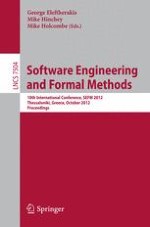This book constitutes the refereed proceedings of the 10th International Conference on Software Engineering and Formal Methods, SEFM 2012, held in Thessaloniki, Greece, in October 2012. The 19 revised research papers presented together with 3 short papers, 2 tool papers, and 2 invited talks were carefully reviewed and selected from 98 full submissions. The SEFM conference aspires to advance the state-of-the-art in formal methods, to enhance their scalability and usability with regards to their application in the software industry and to promote their integration with practical engineering methods.
